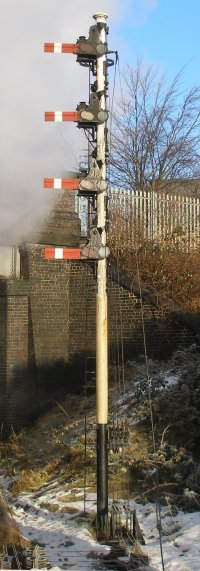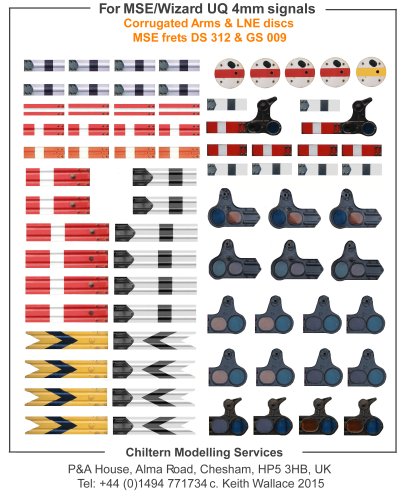
London North Eastern Railway (LNER) Upper Quadrant 4mm Signal
Waterslide Transfers (decals) for MSE/Wizzard etched arms
Order Now!
4mm UQ Corrugated Signal + LNE disc Waterslide Transfers for MSE/Wizzard etched arms sheet GBP 5.19
![]()

The LMS, LNE and Southern Railways agreed fairly quickly on a standard Upper Quadrant signal arm. The Great Western Railway stuck with its tried and tested lower quadrant arm, but all four companies were producing steel arms from the 1930s onwards.
And on all four there was a similar evolutionary process. Initially steel arms were produced by forming horizontal corrugations. On the GWR these were along the top and bottom edges of the arm. In the Upper Quadrant school the arm had two horizontal corrugations within the body of the arm, with a large prominent cast iron washer for the fifth bolt.
Although these were formed simply enough in a press, they were still a relatively complex shape. The Upper Quadrant designs were the first to abandon corrugations and create the required stiffening with a folded lip along the top and bottom edges. The GWR followed suit around 1948. There are thought to be none of the Upper Quadrant arms of the LMS or LNER corrugated type in service either on the main line or in preservation. The Southern appears to have stuck with the corrugated type much longer - the famous large Down bracket at Southampton Central had examples until its demise in the 1970s; and the Bluebell has spotted a couple on its latest bracket signal at Horsted Keynes. The only surviving GWR ribbed arms are on preserved railways (Didcot and the Severn Valley having examples).
I have yet to find a date from when the folded-edge type was introduced. The most recent plan I have seen for a corrugated arm was issued by Derby S&T in 1935, and the impression is that the LMS and LNE abandoned corrugated arms early in the process.
However the first folded-edge types continued to feature the large cast-iron washer, and this was ultimately phased out by the LMS and LNE, but remained a feature of SR arms for much longer.
The 1935 Derby plan has a note about the large cast iron washer, which suggests that the washer + bolts featured on vitreous enamelled arms, but were replaced by a bolt + rivets + a vertical strengthening bar on the back of the arm on spray enamelled arms. The wording is confusing, but what is clear is that the fittings are determined by the coating.
The other major variation lies in the ground signal discs; and each railway company had its own unique design.
The Great Central Railway has done a great job of recreating traditional signalling, and this wonderful 'set' of corrugated shunting arms at Loughborough (image left).are of LMS manufacture, although to the same design as the LNE corrugated arms.
As there appears to be sufficient interest in corrugated arms and LNE-types, a sheet for these types has now been prepared.
If any one knows the locations of any LMS or LNE corrugated types where they might be photographed, please do e-mail me.
Meanwhile a visit to the Mangapps Farm Railway Museum in Burnham-in-Crouch has seen the project leap forward and as of 11 February 2015 a 'beta' set of transfers is ready to go to our 'tester' who has the perfect target signal for these on his workbench as I type!

You would think that a sheet of transfers might be self explanatory, but that are subtle variations between railway companies intended to trap the unwary.
This sheet provides a series of corrugated full-length arms with cast iron washer as used by the LMS, LNE and Southern Railways from c. 1924 onwards. These are designed to fit the MSE brass etched frets, and therefore differ from both the official plans (I have a Derby plan dated 1935) and the prototype. It should also be noted that the Alan Gibson arms are very similar; the Mainly Trains and Spratt & Winkle types are larger, whilst the Ratio plastic ones are spot on!
Looking at the sheet, (left) in the left hand column the first five rows feature shunting signal arms, as can be seen today on the Great Central Railway in Loughborough. The first four rows have been photo-shopped, but the fifth row is as per the prototype; the faded red reflects the fact that these are south facing! The third row purports to be a calling-on arm, but these are - currently - conjectural as I have not been able to locate a photo of such an arm. However the location of the corrugation lends itself to this treatment, and the principle of 'calling on' a loco into an occupied platform or a banking engine onto the rear of waiting train was well established in the lower quadrant era so it follows that there would be a corrugated signal arm.
Rows 6 & 7 are Southern Railway '3 foot' arms, although these actually scale out at 2' 10.125" using the diagrams and dimensions in George Pryer's 'A Pictorial Record of Southern Signals'. The book shows that these shorter corrugated arms would be on the lower dolls of a bracket signal, with the main line have a full-sized folded-edge arm, with this arrangement surviving in a number locations to the end of the steam era. These have been photoshopped from elements of the full sized arm using the Pryer dimensions for markings, etc.
The final 8 rows are genuine signals: the Home arm is at Mangapps and is a Southern arm, whilst the Distant is in a private collection and is LMS in origin.
The right hand column starts with a sets of LNER discs; also courtesy of Mangapps. These also have been adjusted to fit the MSE fret. The Mangapps Farm Railway Museum has a wonderful LNER shunting signal, and this is offered as a full arm, including spectacle plate.
There are then a set of later-style (BR) spectacle plates front and back - do check whether you've got the home or distant if using them instead of the more conventional glazing. The final row is a set of genuine LNER spectacle plates. The intention is that spectacle plate on the etch is painted black and then the transfer affixed over the painted arm. The provision of spectacle plates follows feedback.
However, a word of caution as the spectacle plates can also be painted. According to the Derby plan, the lower part of the spectacle plate front should be painted red (so a band continuing the red of the blade), with the rest of the front black. The Derby document also shows the part of the spectacle plate that overlaps the white blade on the rear should also be painted white.
That was the official diagram. In reality the majority of spectacle plates were black both front and back. Whether they were painted or not might be down to the individual preference of the S&T team, and whether anyone had bothered to bring the tins of paint and brushes (or was prepared to spend another day on the job up a post wavering around in the wind).
The cast iron spectacle plate is pretty universal, and carefully study shows that the design retained the depressions that matched the corrugations long after the corrugated arms had been phased out. The reality is probably that the spectacle plate had a much longer working life that the attached mild steel arm. Only the Southern seems to have produced a pressed steel spectacle plate, which is flat on the rear, with folded edges matching the later arms.
In the later BR period grey appeared on spectacle plates and on the bottom of posts.
The moral of all this is - as with locomotives - if you are modelling a particular area or a specific signal, then work from photos. This is easier said than done, as most people photographing both locos AND signals for some bizarre reason always seem to photograph the front...
